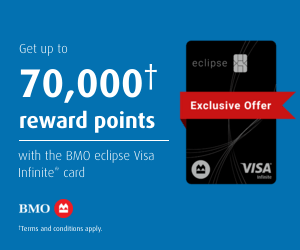While it might sound like helpful financial protection, these premiums can be expensive and often aren't the best solution – especially when alternatives like building an emergency fund or using one of the top balance transfer cards may serve you better.
The article below discusses what a balance protector premium is, how it works, and how to tell if it's a worthwhile product for you.
Key Takeaways
- A balance protector premium is a type of insurance coverage that helps you pay off your credit card in certain emergency situations.
- It covers situations like job loss, critical illness, disability, and death.
- The fee for this balance protection is usually a percentage of your current balance.
Never miss an amazing deal again + get our bonus 250+ page eBook for FREE. Join 50,000 other Canadians who receive our weekly newsletter – learn more.
What is a balance protector premium?
Sometimes called balance protection insurance, a balance protector premium is a type of insurance coverage that helps pay your outstanding credit card balance in the event of an unforeseen event that affects you or a family member.
Essentially, it's like having credit card insurance, but specifically on your balance.
Possible situations and/or events that could trigger the need for a balance protector premium include:
- Job loss
- Hospitalization
- Disability or critical illness diagnosis
- Strike
- Death
It's important to note that paying a balance protector premium doesn't guarantee 100% coverage. Be sure to discuss any questions with your credit card provider and always read the terms and conditions carefully.
How balance protection insurance works
If you’re like most Canadians, you carry some credit card debt from month to month, but you’re able to make your monthly payments. You know that if something unexpected happened, you'd struggle to make that credit card payment.
Banks and financial institutions also realize this, and they offer balance protection coverage as an optional product. Users pay a monthly fee, typically a percentage of their balance, for the peace of mind that the bank will make their minimum monthly payments if they are unable to do so.
For example, if you want to participate in RBC’s balance protector program, you’d pay $1.20 per $100 of your balance (up to $25,000). So, if you have a $500 balance, you’d pay $6 a month (until your balance changes).
You can cancel balance protection coverage at any time, but many programs self-terminate early, like when you reach age 66 or if your credit card is cancelled.
What does balance protection insurance cover?
The idea behind balance protection insurance is that it covers your credit card payment if you’re unable to make it due to an eligible reason.
Here are the details on the main situations where balance protection insurance/balance protector premiums kick in:
1. Job loss and loss of self-employment
If you lose your job or income from self-employment, your balance will be covered with most balance protection insurance policies.
Your coverage will stipulate here the specific amount of coverage, typically ranging from 10% to 20% of your balance, up to a maximum amount. This will be paid monthly for a specific period, usually between 5 and 10 months, until you've reached the cap.
For example, with RBC’s Balance Protector program, RBC will pay up to 25% of your balance for up to 4 months, with a maximum of $6,250 per month.
2. Critical illness
Balance protection insurance may pay off your balance in full (or up to a maximum amount) if you develop a critical illness.
However, insurance policies are notoriously exclusive about what they cover. For instance, a critical illness caused by a pre-existing condition may not be eligible. Usually, balance protection programs list specific illnesses that are covered.
3. Disability
If you become disabled and find yourself unable to work, you may be eligible for a percentage of your balance to be paid off up to a certain amount.
Looking at the RBC Balance Protector example, you'll be covered for 25% of your balance, up to a maximum of $25,000.
4. Death
In the unfortunate event that you pass away, balance protection insurance will work the same way as the provisions for critical illness.
Looking at our RBC Balance Protector example, users can receive one-time coverage of $25,000.
Important: Balance protection insurance is notoriously exclusive, meaning the policies are very particular about what is covered and what isn’t. Before you purchase coverage, read through the fine print.
The fine print outlines details, including definitions of "job loss" and "disability." If you choose to sign up for balance protection insurance with any bank, it's essential to understand what you're getting into.
Is balance protection insurance worth it?
In most cases, it isn't worth paying the extra for balance protection insurance or balance protector premiums. Especially if you already have other types of coverage, like health and life insurance.
If you have a significant balance on your credit card, having 10% to 25% of it protected isn't likely to make a substantial difference in the long run.
Plus, coverage is only extended to the balance before the event that caused the disability, death, or layoff. You'll still have future payments to make, and it's not guaranteed that it will be that much help.
Depending on your balance, you'll have to pay more to insure more. So, the larger your balance, the more you'll have to pay. The RBC balance protector premium is $1.20 per $100 – if you're racking up relatively sizable balances, you'll be paying more and more for balance protection insurance month after month. This can really add up.
And remember the terms and conditions. We outlined some of the fine print that could disqualify you from coverage, so it's always important to read it carefully.
That being said, there is always the unknown. With proper financial planning, you'll likely not need to pay money for this service.
Alternatives to balance protection insurance
It’s better to access money you already have than to pay more for potential coverage, so setting money aside for emergencies is a good place to start. You can open a high interest savings account with a valuable rate that helps your savings earn more.
Another way to avoid balance protection insurance is to pay down your existing credit card debt. Open a balance transfer credit card and move the balance from your current credit card (which can have interest rates of over 19.99%) to one with a significantly lower interest rate.
As long as you pay it off within the balance transfer period, you can save a ton on interest and be on your way to getting rid of the balance.
The following credit card has a temporary 0% interest rate and no annual fee:
FAQ
What is a balance protection premium?
A balance protection premium is an optional type of insurance coverage. It can help pay some of your outstanding credit card balances in cases of emergency or financial setback, like job loss, strike, disability, or death.
How do I get rid of the balance protector premium with RBC?
To cancel your RBC balance protector premium, you can call them at 1-800-769-2512 or visit your nearest branch. You can consider alternatives to this RBC product, like an HISA for an emergency fund or using a balance transfer credit card.
Is RBC BalanceProtector Max worth it?
Using this or any other balance protection insurance product is a personal choice. It may be better to work on paying down your debt, using a balance transfer credit card, or purchasing life insurance coverage that provides similar financial security.
What does TD balance protection cover?
In the event of your death, this protection plan will either pay a lump sum or pay off your balance in full. In cases of job loss or total disability, you'll receive payments up to $25,000 each month.
creditcardGenius is the only tool that compares 126+ features of 231 Canadian credit cards using math-based ratings and rankings that respond to your needs, instantly. Take our quiz and see which of Canada's 231 cards is for you.



 ×2 Award winner
×2 Award winner  $50 GeniusCash + 0% on balance transfers for 12 months (3% fee) + No annual fee.*
$50 GeniusCash + 0% on balance transfers for 12 months (3% fee) + No annual fee.*





 GC:
GC: 












.png)






















Comments
Leave a comment
Required fields are marked with *. Your email address will not be published.